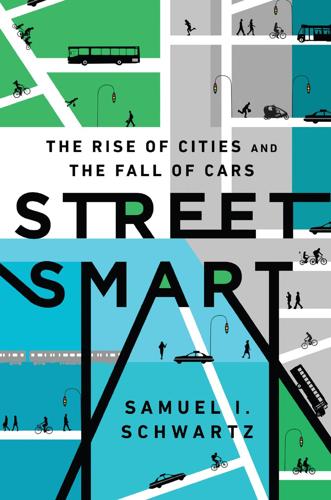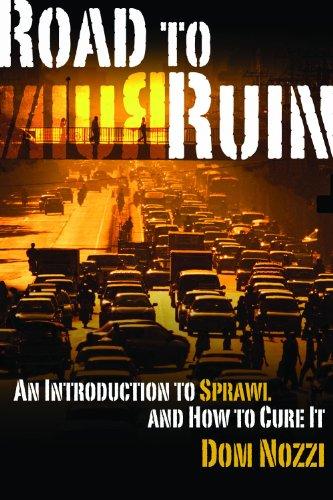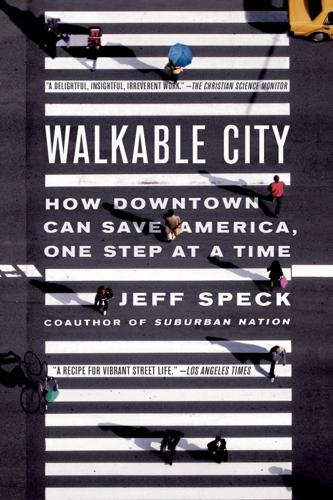skinny streets
description: narrow streets designed to limit vehicle speed and prioritize pedestrian safety.
7 results

Street Smart: The Rise of Cities and the Fall of Cars
by
Samuel I. Schwartz
Published 17 Aug 2015
This can make Portland’s residents a little smug about the Rose City, but they’ve earned the right. Vehicle miles traveled have fallen 20 percent further in Portland than the US average, and the typical Portlander drives four miles less and eleven minutes less than the average American daily. Exhibit A (there will be more) is the Portland Bureau of Transportation’s “Skinny Streets” program. Skinny streets are just what they sound like: a reduction in the dimensions of roadways by modifying municipal standards. There are dozens of benefits for putting streets on this sort of diet, including increased safety, lower resurfacing costs, and even a reduction in heat re-radiation, which is one of the causes of what are known as “urban heat islands”: metropolitan areas that are warmer than the areas surrounding them because of surfacing materials.
…
Since the stuff used to pave roads and parking lots stores short-wave radiation from the sun, and then returns it with interest as heat, cities get hotter than they would otherwise be, which is not something we really need more of in an era of underlying global warming. But the best thing about skinny streets is that they promote active transportation, both by slowing down cars and by permitting the widening of sidewalks. The campaign to put America’s streets on a diet dates back to 1999, when a pedestrian advocate named Dan Burden published a fifty-two-page document titled Street Guidelines for Healthy Neighborhoods and set out, with illustrations and maps, recommendations for reducing the width of residential streets from the typical thirty-six feet (or more) recommended by the American Association of Highway and Transportation Officials to no more than twenty-eight feet, with parking on both sides.
…
A twenty-eight-foot-wide street with parking on both sides has room for only one traffic lane, which sounds crazy, but not in Portland, which has literally hundreds of miles of two-way streets on which drivers have to wait their turn to pass. These aren’t farm roads; the Portland ordinance allows skinny streets in residential areas with densities of nearly nine homes per acre. Road diets are not just a Portland obsession. San Francisco has completed the most road diet programs in the country—more than forty as of this writing. That includes Valencia Street, which was a four-lane road until 1999, when the traffic authorities got out their paint buckets and restriped the street with two traffic lanes, a center median that permitted left turns but no through traffic, and, for the first time, bike lanes.b In 2012, San Jose started implementing its own version of a road diet, part of a new plan for pedestrian safety, that turned half a dozen streets from one-way to two-way.

Road to ruin: an introduction to sprawl and how to cure it
by
Dom Nozzi
Published 15 Dec 2003
Well known for its traffic-calming efforts in recent years, Portland, Oregon, has a “skinny streets” program for new residential areas: 20 feet wide with parking on one side, or 26 feet wide with parking on both sides. The city has found that such streets help maintain neighborhood character, reduce construction costs, save vegetation, reduce stormwater runoff, improve traffic safety, and make it possible to use scarce land for other than motor vehicle purposes.18 The Portland Fire Department has discovered that skinny streets provide adequate access for emergency vehicles. (It has been noted that it would be more economical to purchase more modestly sized fire trucks that fit local streets than to build all streets to meet the needs of the largest size trucks.)

Suburban Nation
by
Andres Duany
,
Elizabeth Plater-Zyberk
and
Jeff Speck
Published 14 Sep 2010
These accidents correlated most closely to street width, with new thirty-six-foot-wide streets being about four times as dangerous as traditional twenty-four-foot-wide streets.al A city sees the light: Portland, Oregon, promotes its new (old) street standards One community that has seen beyond the false safety promised by wide streets is Portland, Oregon, whose fire chief helped to initiate a new public program called “Skinny Streets.” This program recommends that new local streets in residential areas, with parking on one side, should be only twenty feet wide. These humane streets have their critics, the usual cabal of fearmongers, who would like to enforce standards ten feet wider. They insist that the numbers don’t add up—how can two cars pass each other and a parked car in a mere twenty feet of pavement? Of course, the founders of the Skinny Streets program have reason for confidence, since they derived their measurements from Portland’s existing streets, which continue to work perfectly well in the city’s most valuable neighborhoods.

Walkable City: How Downtown Can Save America, One Step at a Time
by
Jeff Speck
Published 13 Nov 2012
Perhaps most fascinating is the way that Portlanders refuse to disobey DON’T WALK signs, even if it’s 1:00 a.m. on a tiny two-lane street swathed in utter silence … and even if a blithe east-coaster is striding happily into the intersection (I’m not naming names here). But what really makes Portland unusual is how it has chosen to grow. While most American cities were building more highways, Portland invested in transit and biking. While most cities were reaming out their roadways to speed traffic, Portland implemented a Skinny Streets program. While most American cities were amassing a spare tire of undifferentiated sprawl, Portland instituted an urban growth boundary. These efforts and others like them, over several decades—a blink of the eye in planner time—have changed the way that Portlanders live.● This change is not dramatic—were it not for the roving hordes of bicyclists, it might be invisible—but it is significant.
…
Rybczynski, Witold Sadik-Khan, Janette Sansone, Leslie Schneider, John Schwarzenegger, Arnold Seinfeld (TV show) Senate, U.S. September 11, 2001 terrorist attacks Sex and the City (TV show) sfpark.org shadow/shaping studies Shared Streets sharrows (wide lanes for cars and bicyclists) Shorto, Russell Shoup, Donald Siegel, Charles Sierra Club Skinny Streets program (Portland, Ore.) skyscrapers Sloan, Alfred, Jr. SmartCode Shareware Smith, Adam Smith, Rick Sottile, Christian Speck, Jeff Spivak, Alvin Standard Oil “starchitects” Stonehenge stop signs streetcars Street Smart algorithm Streets of San Francisco, The (TV show) Suburban Nation (Duany, Plater-Zyberk, and Speck) suburbia; car dependency in; false sense of safety in; isolation of houses in; obesity in subways Summers, Nick Surface Transportation Policy Project Swift, Peter “Synchro” traffic-modeling software Talbot, Noah Tamminen, Terry Target taxis Ten Steps of Walkability Texas A&M University Texas Transportation Institute Thomas, John “3-Way Street” (aerial video) “Top Ten Walking Cities” (Lonely Planet travel guides) Toronto, University of Toward a History of Needs (Illich) Trading with the Enemy (Higham) Traditional Neighborhood Development Ordinance traffic; building of roads and; as calmed by pedestrians; congestion; fatalities; and fuel use; health problems and; on-street parking and; plans for reduction of; push-button signals for; speed of, stress and; time wasted in; two-way vs. one-way; volume of, street size and Traffic (Vanderbilt) traffic engineers traffic signals traffic studies transit systems; conditions needed for success of; costs of; favorability toward; funding for; health benefits for users of; highways vs.; household savings and; investments in; job creation and construction of; linear corridor; local density needed for; neighborhood structure needed for; property values and; small nodal; walkability and; see also trolley lines; specific names of systems Transportation Department, U.S.

Singularity Sky
by
Stross, Charles
Published 28 Oct 2003
Some of them had half melted in the heat of re-entry; others pinged and ticked, cooling rapidly in the postdawn chill. An inquisitive pigeon hopped close, head cocked to one side; it pecked at the shiny case of one such device, then fluttered away in alarm when it beeped. A tinny voice spoke: "Hello? Will you entertain us?" The Festival had come to Rochard's World. A skinny street urchin was one of the first victims of the assault on the economic integrity of the New Republic's youngest colony world. Rudi—nobody knew his patronymic, or indeed his father—spotted one of the phones lying in the gutter of a filthy alleyway as he went about his daily work, a malodorous sack wrapped around his skinny shoulders like a soldier's bedroll.

Retrofitting Suburbia, Updated Edition: Urban Design Solutions for Redesigning Suburbs
by
Ellen Dunham-Jones
and
June Williamson
Published 23 Mar 2011
We believe so and credit the design of the streets as well as programming and design of the skating rink/plaza and town green. The new public streets at Belmar have a right-of-way of seventy-five feet with generously wide sidewalks, leaving only thirtyfour feet for the roadway, too narrow by Lakewood street standards. Lakewood worked hard with the local fire district to change the standards for Belmar. The skinny streets slow traffic, improving safety for pedestrians. They allow good visibility across streets, aiding the retail’s viability. And, perhaps most importantly to the project’s long-term sustainability, in conjunction with the three- to five-story buildings, they create the sense of a beautifully outfitted outdoor public room with the kind of spatial intimacy that is conducive to social interaction and community building.

Ghost Train to the Eastern Star: On the Tracks of the Great Railway Bazaar
by
Paul Theroux
Published 9 Sep 2008
Some travel didn’t involve locomotion, but instead periods of residence and reflection, a weightless orbiting, as when I became almost invisible and seemed to dissolve, ghost-like again, in an agreeable location, an aromatic version of home, days of work and thought when I remained monkishly in my head, unaware of the exotic – days when I would emerge from my hotel room into a crowded Asiatic lane as though I’d been beamed there as ‘matter transfer’ by a hot light, surprised to see a bazaar and rickshaws and skinny street vendors, pretty girls staring, and I would laugh: What am I doing here? I’d come to see that travel for me was no longer a fun-seeking interlude, not even the roundabout detour of heading home, but a way of living my life: a trip without an end where the only destination was darkness. The beauty of it was that I was doing it in the simplest way, as a homeless person with a small bag and a briefcase of papers, rubbing across the world, travelling light.